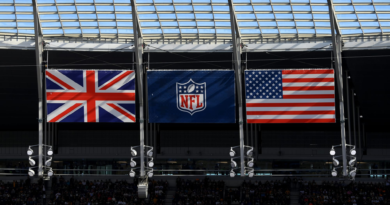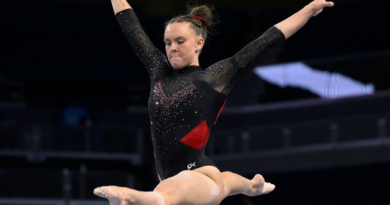Why no lead is safe, the Sam Bennett effect and other Round 2 lessons of the Stanley Cup playoffs
Sixteen games have been played in the second round of the 2024 Stanley Cup playoffs. Some trends from Round 1 have continued. Others have not.
With multiple teams on the cusp of elimination, it’s time for another set of playoff takeaways, courtesy of NHL reporters Ryan S. Clark and Kristen Shilton.

Jake Oettinger bolstering his case to be Team USA’s No. 1 goalie
Thatcher Demko. Connor Hellebuyck. Jake Oettinger. Jeremy Swayman. These appear to be the four leading names for who could play goal for the United States at the upcoming 4 Nations Face-Off in 2025, along with the Winter Olympics in 2026.
Having their pick of these goaltenders reinforces the belief that the U.S. is one of the front-runners to win both tournaments. Of course, one of them is expected to miss out, with teams usually taking three goalies. That’s a question that will likely get answered over time. But right now, Oettinger is using the 2024 playoffs to make a case to not only make the team but potentially get the nod in net.
Oettinger’s 24-save performance in the Dallas Stars‘ 5-1 win in Game 4 against the Colorado Avalanche means he is now 7-4 with a 2.12 goals-against average and a .923 save percentage this postseason. He has provided the sort of stability that has allowed the Stars to come within a game of reaching the Western Conference finals. And he did it while playing a proverbial SEC schedule, with the Stars facing the defending Stanley Cup champion Vegas Golden Knights in the first round followed by the Avs, who won the Cup in 2022.
It’s possible that Demko, who has battled injuries the last few months, could return for the Vancouver Canucks if they can reach the conference finals. Hellebuyck, who is the favorite to win the Vezina Trophy, endured his most challenging postseason, with a GAA that was north of 5.00 and an .870 save percentage. As for Swayman, he’s posted a 2.28 GAA with a .920 save percentage, although the Boston Bruins‘ past three losses to the Florida Panthers have seen him surrender more than three goals per game since winning Game 1 of the series.
Other factors will go into the team selection (and lineup) process. But this postseason, Oettinger is providing the consistent high-level goaltending that Team USA will need in the upcoming best-on-best tournaments. — Clark
Bennett didn’t arrive until Game 3 of the Florida Panthers‘ series against the Boston Bruins, but suffice it to say, the man has made his mark. The Panthers forward has one goal, one assist, one controversial hit on Brad Marchand (that took the Bruins’ captain out of Game 4 with an upper-body injury) and one contentious scoring sequence under his belt already.
And the fans in Boston were happy to let Bennett have it whenever he touched the puck in Game 4.
Bennett is the latest example of a player becoming a playoff lightning rod. The question is: Will his antics galvanize the Bruins from here and help them overcome a 3-1 series deficit? Or is Bennett’s button-pushing going to give Florida further confidence to stay on top of its Atlantic Division rivals?
Game-changers in the playoffs aren’t always determined through the X’s and O’s, and Bennett has certainly spiced up the Florida-Boston matchup in unexpected ways. — Shilton
0:50
Sam Bennett evens score with clutch power-play goal
Sam Bennett takes advantage on the power play and nets a huge goal for the Panthers to even the score against the Bruins.
Why can’t anyone in the West hold a lead?
One of the common threads in the Western Conference semifinal series is that no lead is safe. The Dallas Stars found that out in Game 1 when the Colorado Avalanche came back from a three-goal deficit to win in overtime. Game 2 saw the Stars build a 4-0 lead only to see the Avs score three before the Stars won 5-3. In Game 3, the Stars had a 1-0 lead until the Avs tied the game. The Stars scored again but were under threat before a pair of empty-net goals gave them a 4-1 lead.
The Edmonton Oilers had a two-goal lead in Game 1 before the Vancouver Canucks won 5-4. The Canucks had a pair of one-goal leads in Game 2 before the Oilers won it in overtime. Game 3 saw the Oilers jump out to a 1-0 lead before the Canucks scored three straight. Even then, the Oilers scored two of the game’s final three goals and made life hectic for the Canucks after they scored early in the third period before losing 4-3.
What is it about the Western Conference right now? Why is it that each of the four teams presents equal arguments for how it can charge out to a lead — and could lose it just as easily? One reason is that all four were rather strong at comebacks in the regular season. The Stars were 23-15-4 when their opponents scored first, while the Avalanche were 20-17-0 when their opponent got the first goal. As for the Oilers, they were 18-18-3 in those situations whereas the Canucks were 12-12-5.
“It’s certainly a mental boost and a pick-me-up if you believe in what your team’s doing and have firepower, which, I think, all the teams have firepower and can score,” Avalanche coach Jared Bednar said. “You get something going your way, it’s snowballing going downhill and the other team is trying to survive for a little bit. If you can capitalize on a chance or two, it starts turning the tide.
“The belief gets stronger and stronger. … When you are playing from behind, you get to a certain part of the game where you have nothing to lose. You’re either going out with a loss or pushing to try and make it a win. I think it’s evenly matched teams, all desperate to try to survive and advance and lay it all on the line.” — Clark
Go big or go deep?
The New York Rangers–Carolina Hurricanes series is a fascinating look at how two great teams approached the trade deadline this season — with varied results.
Last season, the Rangers went all-in, acquiring Patrick Kane and Vladimir Tarasenko to (theoretically) give them a boost come playoff time. New York’s would-be stars never acted their part, and the Rangers made a first-round exit. This season, New York added depth in Alex Wennberg and Jack Roslovic so that its core could shine as is — and it’s working.
Meanwhile, Carolina followed the Rangers’ script from last season with the deadline blockbuster (hello, Jake Guentzel). But somehow, the Hurricanes’ ship plotting toward a Stanley Cup Final took on significant water in the second round.
Now, it’s not all due to one factor (or player). But this illustrates how it’s not always big swings that ultimately determine a team’s fate. Maybe it’s a mindset or mentality that comes with staying the course. New York essentially bet on itself to get the job done, and it’s working. Carolina gathered reinforcements, and that hasn’t paid off as quickly. And oddly enough, if anyone can relate, it’s the Rangers. — Shilton
Lingering questions on the Oilers’ goaltending
Stuart Skinner has become a topic of conversation for a second straight postseason. Last year, he was a rookie who was pulled four times, with three of those early exits coming in the second round. Fast forward to this postseason. In Game 3, he was pulled after two periods and now has a 4.63 goals-against average and a .790 save percentage in three games against the Canucks.
It left Oilers coach Kris Knoblauch with a decision ahead of Game 4. Should he return to Skinner? Or turn to Calvin Pickard, who replaced Skinner in Game 3? Or does that all open the door for Jack Campbell? According to local media reports Tuesday, Pickard is getting the nod for Game 4.
But how will the decision facing Knoblauch this postseason impact the club going forward? Campbell is under contract for three more years at $5 million annually, while Skinner has two years left at $2.6 million annually. Pickard is a pending unrestricted free agent on a team that Cap Friendly projects will have a little less than $9 million in space in the offseason.
The past five years have watched the Oilers go from a team of promise with two generational talents in Leon Draisaitl and Connor McDavid to one that carries championship expectations into each season. In that time, the Oilers’ front office has worked to address their needs, which have ranged from finding secondary scoring to strengthening a defense to getting the goaltenders they feel can help them win a title.
But with their current situation, what could next season look like for the Oilers in goal? Especially when they have 10 UFAs, seven of whom are forwards. And even that comes with the context that whatever they do this offseason could impact what happens in the summer of 2025, when Draisaitl could hit the open market. — Clark
Is Edmonton built to last?
There’s no doubt the Oilers can score. They’ve done plenty of it in the postseason. But is Edmonton designed to win over the long haul here?
Consider that the Oilers have tallied 33 goals total — but only 17 at even strength. That top-ranked power play has been a vital part of Edmonton’s success to date, and now it is experiencing what happens when it runs up against a sensational penalty kill like Vancouver’s. Pucks can stop finding twine as frequently on the man advantage. The Oilers are 4-for-8 on the power play through three games; the Canucks are nearly matching them, though, at 3-for-9. If the special teams battle becomes neutral ground, it’s fair to question whether the Oilers can get out of the second round based purely on their even-strength play.
McDavid has one 5-on-5 goal in the playoffs. Draisaitl has two. But each has 10 total points on the power play. Maybe there’s still a shift coming. That special teams mojo better start translating throughout the game for Edmonton, though. — Shilton






